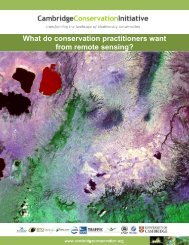Climate change adaptation for biodiversity
Climate change adaptation for biodiversity - Cambridge ...
Climate change adaptation for biodiversity - Cambridge ...
- No tags were found...
Create successful ePaper yourself
Turn your PDF publications into a flip-book with our unique Google optimized e-Paper software.
<strong>Climate</strong> <strong>change</strong> <strong>adaptation</strong> <strong>for</strong> <strong>biodiversity</strong><br />
Introduction<br />
• Global <strong>biodiversity</strong> is in trouble 1 .<br />
• Whilst conservation activity has reduced this decline, substantial increases in the<br />
magnitude of conservation ef<strong>for</strong>t are required in the longer term 2 .<br />
• <strong>Climate</strong> <strong>change</strong> has contributed to some <strong>biodiversity</strong> declines (Box 1), and is likely to<br />
become increasingly important through time 3 .<br />
• Biodiversity conservation will increasingly need to take account of climate <strong>change</strong>.<br />
Adaptation<br />
• Adaptation is defined as initiatives and measures to reduce the vulnerability of natural<br />
and human systems against actual or expected climate <strong>change</strong> effects.<br />
• Some have suggested <strong>adaptation</strong> will require a paradigm shift in conservation. Others,<br />
that it involves the application of existing conservation approaches in a changing<br />
climate 4 .<br />
• Helping <strong>biodiversity</strong> adapt is important <strong>for</strong> maintaining ecosystem services integral to<br />
livelihoods and to human climate <strong>change</strong> <strong>adaptation</strong>.<br />
• There is an urgent need <strong>for</strong> practical guidance on what conservation <strong>adaptation</strong> should<br />
look like, and how it relates to the <strong>adaptation</strong> of other sectors.<br />
<br />
<br />
<br />
<br />
<br />
<br />
<strong>Climate</strong>-smart conservation actions<br />
• Adaptation action undertaken now should be based on existing conservation measures<br />
which are also likely to be useful in a changing climate (climate-smart actions).<br />
• These are likely to be effective now and are best understood because they are based on<br />
current conservation practice.<br />
• They can be identified by considering the most likely impacts of climate <strong>change</strong> on<br />
species and habitats, but also include some general actions that will always be<br />
beneficial (Box 2).<br />
• Reducing the severity of existing threats to species will always be beneficial.
<strong>Climate</strong> <strong>change</strong> <strong>adaptation</strong> <strong>for</strong> <strong>biodiversity</strong><br />
<br />
• <br />
<br />
• <br />
<br />
• <br />
<br />
• <br />
<br />
• <br />
<br />
• <br />
<br />
• <br />
<br />
<br />
<br />
<br />
<br />
<br />
<br />
<br />
<br />
56 .
<strong>Climate</strong> <strong>change</strong> <strong>adaptation</strong> <strong>for</strong> <strong>biodiversity</strong><br />
Novel conservation actions<br />
• With an increasing magnitude of climate <strong>change</strong>, then more novel conservation actions<br />
will need to be considered.<br />
• These are less closely related to existing conservation action, and there<strong>for</strong>e less well<br />
understood, less certain in their feasibility and effectiveness and potentially more risky<br />
with greater potential <strong>for</strong> unintended consequences (Box 5).<br />
<br />
• <br />
<br />
• <br />
<br />
• <br />
<br />
• <br />
<br />
• <br />
<br />
<br />
Towards an <strong>adaptation</strong> strategy<br />
• Conservationists will need to progress along a spectrum of actions from those based on<br />
existing conservation actions to novel actions as climate <strong>change</strong> increases (Box 7).<br />
• In the short-term, <strong>adaptation</strong> actions should build upon existing conservation action to<br />
minimise risk and maximise effectiveness. This will also make the most of limited<br />
conservation resources, focusing on those options which deliver outcomes now that are<br />
also likely to be climate-smart. Many of these will build resilience to <strong>change</strong>.<br />
• In the longer-term, with increasing severity of climate <strong>change</strong>, more radical and novel<br />
actions may be required to accommodate and manage <strong>for</strong> <strong>change</strong>. Because of the<br />
uncertainties and risks associated with these, they should <strong>for</strong>m the focus of research<br />
ef<strong>for</strong>t now 7 . Some measures may require lengthy lead-in time (e.g. woodland creation).<br />
• A shift in conservation approach may be required with increasing severity of climate<br />
<strong>change</strong>, from actions to build resilience, which may buy time <strong>for</strong> vulnerable species and<br />
habitats, to those accommodating responses to <strong>change</strong>, such as promoting range shifts.<br />
Understanding how to manage and time this shift will require detailed ecological<br />
knowledge and <strong>biodiversity</strong> monitoring, and the trial of novel techniques.<br />
• Through time, the past distribution and abundance of species will become less relevant<br />
<strong>for</strong> setting future conservation objectives, which should increasingly be based on the<br />
<strong>biodiversity</strong> potential in new climates and changing conservation need.
Conclusions<br />
<strong>Climate</strong> <strong>change</strong> <strong>adaptation</strong> <strong>for</strong> <strong>biodiversity</strong><br />
<br />
<br />
<br />
<br />
.<br />
<br />
<br />
<br />
<br />
<br />
<br />
<br />
<br />
<br />
<br />
<br />
<br />
<br />
<br />
<br />
<br />
Conservation organisations should:<br />
• Focus conservation ef<strong>for</strong>t on existing actions which are climate-smart, to build<br />
resilience.<br />
• Develop robust monitoring and research of climate <strong>change</strong> impacts on populations,<br />
species, habitats and ecosystems.<br />
• Reduce exposure and increase resistance of vulnerable species to negative climate<br />
<strong>change</strong> impacts.<br />
• Undertake research and testing of novel options to increase their feasibility and<br />
reduce their risk when required in the future.<br />
• When climate <strong>change</strong> exceeds the capacity to provide resilience, shift to measures<br />
which accommodate and manage <strong>for</strong> <strong>change</strong>.




